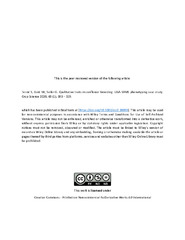Приказ основних података о документу
Qualitative traits in sunflower breeding: UGA-SAM1 phenotyping case study
| dc.creator | Terzić, Sreten | |
| dc.creator | Zorić, Miroslav | |
| dc.creator | Seiler, Gerald | |
| dc.date.accessioned | 2022-02-03T12:10:35Z | |
| dc.date.available | 2021-03-09 | |
| dc.date.issued | 2020 | |
| dc.identifier.issn | 1435-0653 | |
| dc.identifier.uri | http://fiver.ifvcns.rs/handle/123456789/2476 | |
| dc.description.abstract | The production of the first permanent, publicly available sunflower (Helianthus annuus L.) association mapping population (UGA-SAM1) provided material to test the usability of morphological descriptors for discriminating germplasm accessions. The objective of this study was to evaluate the phenotypic diversity in the UGA-SAM1 population and evaluate the usefulness of qualitative traits for the discrimination of genotypes. The SAM1 population consists of 285 accessions characterized for 20 morphological traits. The Shannon–Weaver diversity index (H′) was used to determine phenotypic diversity, whereas HOMALS (homogeneity analysis by alternating least squares) and association statistics were used to determine discriminative power of the descriptors. Phenotypic diversity was moderately high for the traits (0.74). The highest diversity was found in the less developed genotypes followed by non-oil genotypes. Pronounced associations in individual genotype groups and category traits, most notably for the maturity trait in the restorer line (RHA) oil group, resulted in both high association and diversity index values. The association test proved to be a useful addition to HOMALS analysis for determining the trait discriminative power. Adequate selection of traits used in germplasm evaluation can improve the efficiency of breeding programs, whereas the loss of variability could be lowered if diversity focused traits were used including leaf, seed, and certain flower traits, instead of only focusing on yield and quality. | sr |
| dc.language.iso | en | sr |
| dc.publisher | Wiley, Hoboken | sr |
| dc.relation | APV 114-451-2126/2016-03: Anatomic characterization of wild sunflower collection as a potential genepool for cultivated sunflower breeding in Vojvodina, financed by the Provincial Secretariat for Higher Education and Scientific Research, AP Vojvodina | sr |
| dc.relation | info:eu-repo/grantAgreement/MESTD/Technological Development (TD or TR)/31025/RS// | sr |
| dc.relation.isversionof | http://fiver.ifvcns.rs/handle/123456789/1982 | |
| dc.rights | embargoedAccess | sr |
| dc.rights.uri | https://creativecommons.org/licenses/by-nc-nd/4.0/ | |
| dc.source | Crop Science | sr |
| dc.subject | discriminative power | sr |
| dc.subject | qualitative traits | sr |
| dc.subject | HOMALS | sr |
| dc.subject | UGA-SAM1 | sr |
| dc.subject | sunflower | sr |
| dc.subject | association mapping | sr |
| dc.subject | morphological descriptors | sr |
| dc.subject | germplasm accessions | sr |
| dc.subject | phenotypic diversity | sr |
| dc.subject | discrimination of genotypes | sr |
| dc.subject | accessions | sr |
| dc.subject | Shannon–Weaver diversity index | sr |
| dc.subject | descriptors | sr |
| dc.subject | breeding efficiency | sr |
| dc.title | Qualitative traits in sunflower breeding: UGA-SAM1 phenotyping case study | sr |
| dc.type | article | sr |
| dc.rights.license | BY-NC-ND | sr |
| dc.citation.epage | 319 | |
| dc.citation.issue | 1 | |
| dc.citation.spage | 303 | |
| dc.citation.volume | 60 | |
| dc.description.other | This is the peer-reviewed version of the following article: Terzić S., Zorić M., Seiler G. Qualitative traits in sunflower breeding: UGA-SAM1 phenotyping case study. Crop Science 2020, 60 (1), 303 – 319. [https://doi.org/10.1002/csc2.20059] | sr |
| dc.identifier.doi | 10.1002/csc2.20059 | |
| dc.identifier.fulltext | http://fiver.ifvcns.rs/bitstream/id/6780/bitstream_6780.pdf | |
| dc.identifier.scopus | 2-s2.0-85081566606 | |
| dc.identifier.wos | 000525798500023 | |
| dc.type.version | acceptedVersion | sr |


